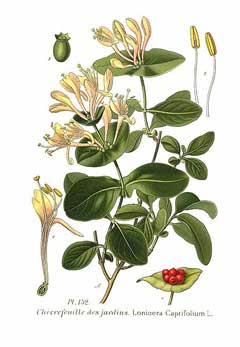 |
|
http://commons.wikimedia.org/wiki/File:152_Lonicera_caprifolium_L.jpg |
 |
| http://da.wikipedia.org/wiki/Bruger:Sten |
Translate this page:
Summary
Physical Characteristics

 Lonicera caprifolium is a deciduous Climber growing to 6 m (19ft) by 6 m (19ft) at a medium rate.
Lonicera caprifolium is a deciduous Climber growing to 6 m (19ft) by 6 m (19ft) at a medium rate.
See above for USDA hardiness. It is hardy to UK zone 5. It is in flower from August to September, and the seeds ripen from October to November. The species is hermaphrodite (has both male and female organs) and is pollinated by Lepidoptera (Moths & Butterflies).
Suitable for: light (sandy), medium (loamy) and heavy (clay) soils. Suitable pH: mildly acid, neutral and basic (mildly alkaline) soils. It can grow in full shade (deep woodland) semi-shade (light woodland) or no shade. It prefers moist soil.
UK Hardiness Map
US Hardiness Map
Synonyms
Plant Habitats
Woodland Garden Dappled Shade; Shady Edge; not Deep Shade;
Edible Uses
Edible Parts: Fruit
Edible Uses: Tea
The fruit is eaten in small quantities[177]. It is probably cooked first[K]. An infusion of the heavily perfumed flowers is used as a tea substitute[7].
References More on Edible Uses
Medicinal Uses
Plants For A Future can not take any responsibility for any adverse effects from the use of plants. Always seek advice from a professional before using a plant medicinally.
Antispasmodic Bach Cathartic Diuretic Emetic Emollient Expectorant Laxative
Pectoral Skin Vulnerary
The fruit is emetic and cathartic[4]. The pressed juice makes a mild purgative[7, 61]. The leaves and flowers are antispasmodic, emollient and expectorant[7]. They are used as a cutaneous and mucous tonic and as a vulnerary[4]. Recent research has shown that the plant has an outstanding curative action in cases of colitis[7]. The seed is diuretic[4]. The plant is used in Bach flower remedies - the keywords for prescribing it are 'Dwelling upon thoughts of the past', 'Nostalgia' and 'Homesickness'[209].
References More on Medicinal Uses
The Bookshop: Edible Plant Books
Our Latest books on Perennial Plants For Food Forests and Permaculture Gardens in paperback or digital formats.

Edible Tropical Plants
Food Forest Plants for Hotter Conditions: 250+ Plants For Tropical Food Forests & Permaculture Gardens.
More

Edible Temperate Plants
Plants for Your Food Forest: 500 Plants for Temperate Food Forests & Permaculture Gardens.
More

More Books
PFAF have eight books available in paperback and digital formats. Browse the shop for more information.
Shop Now
Other Uses
Essential
An essential oil has been extracted from the flowers and used to make a very sweet perfume, but yields are extremely low[7].
Special Uses
Scented Plants
References More on Other Uses
Cultivation details
Prefers a good moist soil with its roots in the shade and its top growing into the light[200]. Succeeds even in quite deep shade[219]. Tolerates both acid and alkaline soils, only showing distress on very alkaline soils[202]. Plants are hardy to about -15°c[202]. Plants are moderately fast-growing[202]. They climb by twining around other plants[182]. The flowers are very fragrant, especially of a night time in order to attract pollinating moths, and are produced in abundance[202, 219, 245], but plants only produce fruit after a hot summer[202]. Plants are prone to attacks by mildew and blackfly[202].
References Carbon Farming Information and Carbon Sequestration Information
Temperature Converter
Type a value in the Celsius field to convert the value to Fahrenheit:
Fahrenheit:
The PFAF Bookshop
Plants For A Future have a number of books available in paperback and digital form. Book titles include Edible Plants, Edible Perennials, Edible Trees,Edible Shrubs, Woodland Gardening, and Temperate Food Forest Plants. Our new book is Food Forest Plants For Hotter Conditions (Tropical and Sub-Tropical).
Shop Now
Plant Propagation
Seed - best sown as soon as it is ripe in a cold frame. Stored seed requires 2 months cold stratification[113] and should be sown as soon as possible in a cold frame. When they are large enough to handle, prick the seedlings out into individual pots and grow them on in the greenhouse for at least their first winter. Plant them out into their permanent positions in late spring or early summer, after the last expected frosts. Cuttings of half-ripe wood, 7 - 10cm with or without a heel, July/August in a frame. Good percentage[78]. Cuttings of mature wood of the current season's growth, 15 - 20cm with or without a heel, November in a cold frame. Good percentage[78]. Layering in autumn[200].
Other Names
If available other names are mentioned here
Native Range
EUROPE: Norway, Sweden, Czechoslovakia, Austria, Hungary, Poland, Former Yugoslavia, Albania, Italy, Romania, Spain
Weed Potential
Right plant wrong place. We are currently updating this section.
Please note that a plant may be invasive in one area but may not in your area so it's worth checking.
Conservation Status
IUCN Red List of Threatened Plants Status :

Growth: S = slow M = medium F = fast. Soil: L = light (sandy) M = medium H = heavy (clay). pH: A = acid N = neutral B = basic (alkaline). Shade: F = full shade S = semi-shade N = no shade. Moisture: D = dry M = Moist We = wet Wa = water.
Now available:
Food Forest Plants for Mediterranean Conditions
350+ Perennial Plants For Mediterranean and Drier Food Forests and Permaculture Gardens.
[Paperback and eBook]
This is the third in Plants For A Future's series of plant guides for food forests tailored to
specific climate zones. Following volumes on temperate and tropical ecosystems, this book focuses
on species suited to Mediterranean conditions—regions with hot, dry summers and cool, wet winters,
often facing the added challenge of climate change.
Read More
Expert comment
Author
L.
Botanical References
1150200
Links / References
For a list of references used on this page please go here
Readers comment
© 2010, Plants For A Future. Plants For A Future is a charitable company limited by guarantee, registered in England and Wales. Charity No. 1057719, Company No. 3204567.